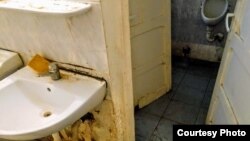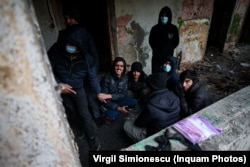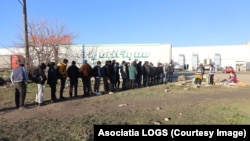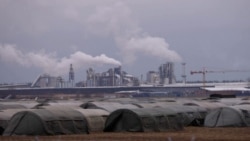BUCHAREST -- NGOs and local leaders say Romania appears ill-prepared for a major influx of refugees if fighting dramatically escalates in neighboring Ukraine and civilians are forced to flee, despite government assurances to the contrary.
They say meager facilities are already stretched thin by the busiest year in decades for asylum applications, in addition to years as a gateway to Europe for migrants from Asia and elsewhere.
NGOs and local leaders have said the government has cited an expansion of only around 2,500 extra places for asylum seekers or refugees, while the direst forecasts suggest a major conflict could send millions of Ukrainians scrambling for the borders.
The warnings this month coincided with a tour of the region by U.S. State Department Counselor Derek Chollet in which he discussed with Romanian officials the possibility of such a wave as Western fears mount of an "imminent" military escalation in Ukraine by Russia.
"Romania has an asylum and receiving system that is made to meet the needs so far, so theoretically we're ready to receive asylum seekers [on the scale] we usually receive [them]," Irene Teodor, from JRS Romania, an NGO that aids refugees, told RFE/RL's Romanian Service, "but it also depends on what numbers we're talking about."
Ukrainian Defense Minister Oleksiy Reznikov said last month that a "major war" could spark "the sudden appearance of between 3 [million] and 5 million Ukrainian refugees fleeing the Russian invasion."
Polish Interior Minister Mariusz Kaminski said on February 13 that his country was preparing to accept refugees from bordering Ukraine.
Romania shares a combined 650 kilometers of border with Ukraine, to its north and east, the most Ukraine has with any EU or NATO member state. Ukraine is home to an ethnic Romanian minority of around 400,000, many of them in the western region of Bukovina.
Limited Numbers
Romania's government last week insisted that the country's five-year national strategy on immigration "creates the necessary levers" for the kind of national cooperation among "relevant" institutions that a sudden surge at the borders would require.
The Interior Ministry's General Inspectorate for Immigration said it has "the necessary legislation, tools, and resources...to process asylum applications and integrate individuals seeking any form of international protection."
But the inspectorate also noted that "in the event of a possible influx of migrants from Ukraine," plans require cooperation among multiple institutions -- something that could prove challenging on Romania's notoriously fractious political scene.
"There is a constant need for preparation and adaptation for a possible increase in the number of asylum applications," the inspectorate acknowledged.
Romania operates six centers to house refugees and other migrants: in the capital, Bucharest; Timisoara in the west; Maramures in the northwest; Suceava in the north; Giurgiu in the south; and Galati in the southeast.
The centers are outfitted to accommodate 1,000 people in all, and were thought to be at around 70 percent occupancy in 2021, following a doubling of the number of migrants from the previous year and a quadrupling from the 2019 figure. Those facilities could theoretically be expanded to add another 1,500 people.
The government also said in a response to an RFE/RL query that the General Inspectorate for Immigration intends to expand the capacities in Suceava, Timisoara, and Galati by a combined 500 places. It has also acquired a building in Crevedia, about 15 kilometers outside Bucharest, that it will eventually adapt to house 500 more people. But that's still just 2,500 extra places.
Some of the centers have been struggling. After multiple complaints, the People's Advocate, the office of the national ombudsman, last year cited overcrowding and other problems in Timisoara, the busiest of the six current migrant centers.
A representative of the Save The Children organization in Romania, Florina Dragulin, who coordinates a refugee project, says authorities "somehow" managed to resolve some of the biggest problems with such centers. But still, she said, "many centers are unsuitable for families."
The situation in Timisoara now "is stable, but not necessarily satisfactory," Mayor Dominic Fritz told RFE/RL's Romanian Service last week.
"It's clear that the management of the migration phenomenon in the west of the country needs improvements, and Timisoara still suffers from this," Fritz said. "We'll have to see in the spring, when it's warm. If the number of migrants increases, then surely the response of the state and the government will have to increase."
But it's unclear if Romanian officials have the luxury of waiting.
Much-Needed Stocks
Romania's recently installed government is led by Nicolae Ciuca, a retired general who spent five years as chief of the Romanian General Staff and two years as defense minister. He already faces challenges over a plagiarism scandal.
Romanian President Klaus Iohannis said last week that his country "must be prepared for an attack scenario" in Ukraine, a country of around 44 million people.
Many Western officials have suggested Russia could be planning a major incursion into Ukraine -- where Kyiv has already been fighting Russia-backed separatists in the east of the country for seven years and Moscow annexed Crimea in 2014.
NGOs could provide more help if a conflict drives civilians across the border, but capacity remains a question. The Romanian Red Cross has said it has stocks for the temporary accommodation of refugees, including bedding, food, and other supplies.
"At the moment, the Romanian Red Cross is making efforts to identify a central warehouse that would allow us to expand the much-needed stocks to 10,000 people, as the existing warehouse is insufficient and is not owned by our organization," the aid group told RFE/RL last week.
Beyond Russian President Vladimir Putin's insistence that NATO guarantee it won't accept Ukraine as a member, Bucharest and Sofia reacted with alarm when the Kremlin demanded last month that NATO keep its troops and infrastructure out of Romania and Bulgaria, which have been members of the military alliance since 2004, and return to its 1997 deployments.
NATO Secretary-General Jens Stoltenberg traveled to Romania on February 11, where he met with Iohannis at a U.S. military base on Romania's Black Sea coast.
His trip came as additional German and U.S. troops and equipment arrived in Romania as part of a rapid reinforcement to try to provide security in the region.













